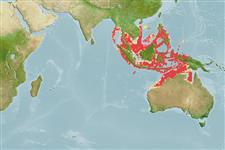>
Eupercaria/misc (Various families in series Eupercaria) >
Nemipteridae (Threadfin breams, Whiptail breams)
Etymology: Nemipterus: Greek, nema, -atos = filament + Greek, pteron = wing, fin (Ref. 45335).
More on author: Bleeker.
Environment: milieu / climate zone / depth range / distribution range
Écologie
marin démersal; non migrateur; profondeur 50 - 200 m (Ref. 9785). Tropical; 17°N - 21°S, 92°E - 140°E (Ref. 3810)
Western Pacific: including the Philippines, Gulf of Thailand, Strait of Malacca, Indonesia and northern Australia. Nemipterus bleekeri has been misapplied to this species by some authors.
Length at first maturity / Taille / Poids / Âge
Maturity: Lm ?, range 11 - ? cm
Max length : 21.0 cm SL mâle / non sexé; (Ref. 3810); common length : 17.0 cm SL mâle / non sexé; (Ref. 3810)
Épines dorsales (Total) : 10; Rayons mous dorsaux (Total) : 9; Épines anales: 3; Rayons mous anaux: 7. Suborbital spine absent. Preopercle with 3 transverse scale rows. Pectoral fins long, reaching to beyond level of anus. Pelvic fins moderately long, reaching to between just short of and just beyond level of anus. A line drawn up from posterior edge of suborbital reaching the dorsal profile at about 2 to 7 scale rows before origin of dorsal fin. Upper lobe of caudal fin falcate, tipped with bright yellow. Axillary scale present. Color: Upper body pinkish mauve, silvery white below. Yellow teardrop-shaped bar beneath eye, extending obliquely halfway to suborbital.
Occurs on mud or sand bottoms in depths greater than 50 m. There is no major fishery for this species (Ref. 3810, 125700).
Life cycle and mating behavior
Maturité | Reproduction | Frai | Œufs | Fécondité | Larves
Males mature at a smaller size than females (Ref. 125700).
Russell, B.C., 1990. FAO Species Catalogue. Vol. 12. Nemipterid fishes of the world. (Threadfin breams, whiptail breams, monocle breams, dwarf monocle breams, and coral breams). Family Nemipteridae. An annotated and illustrated catalogue of nemipterid species known to date. FAO Fish. Synop. 125(12):149p. Rome: FAO. (Ref. 3810)
Statut dans la liste rouge de l'IUCN (Ref. 130435: Version 2024-1)
Menace pour l'homme
Harmless
Utilisations par l'homme
Pêcheries: intérêt commercial mineur
Outils
Articles particuliers
Télécharger en XML
Sources Internet
Estimates based on models
Preferred temperature (Ref.
123201): 20.6 - 27.9, mean 25.3 °C (based on 293 cells).
Phylogenetic diversity index (Ref.
82804): PD
50 = 0.5000 [Uniqueness, from 0.5 = low to 2.0 = high].
Bayesian length-weight: a=0.01514 (0.00873 - 0.02625), b=3.00 (2.86 - 3.14), in cm total length, based on LWR estimates for this species & Genus-body shape (Ref.
93245).
Niveau trophique (Ref.
69278): 3.8 ±0.5 se; based on size and trophs of closest relatives
Résilience (Ref.
120179): Haut, temps minimum de doublement de population inférieur à 15 mois (Preliminary K or Fecundity.).
Fishing Vulnerability (Ref.
59153): Low vulnerability (16 of 100).
